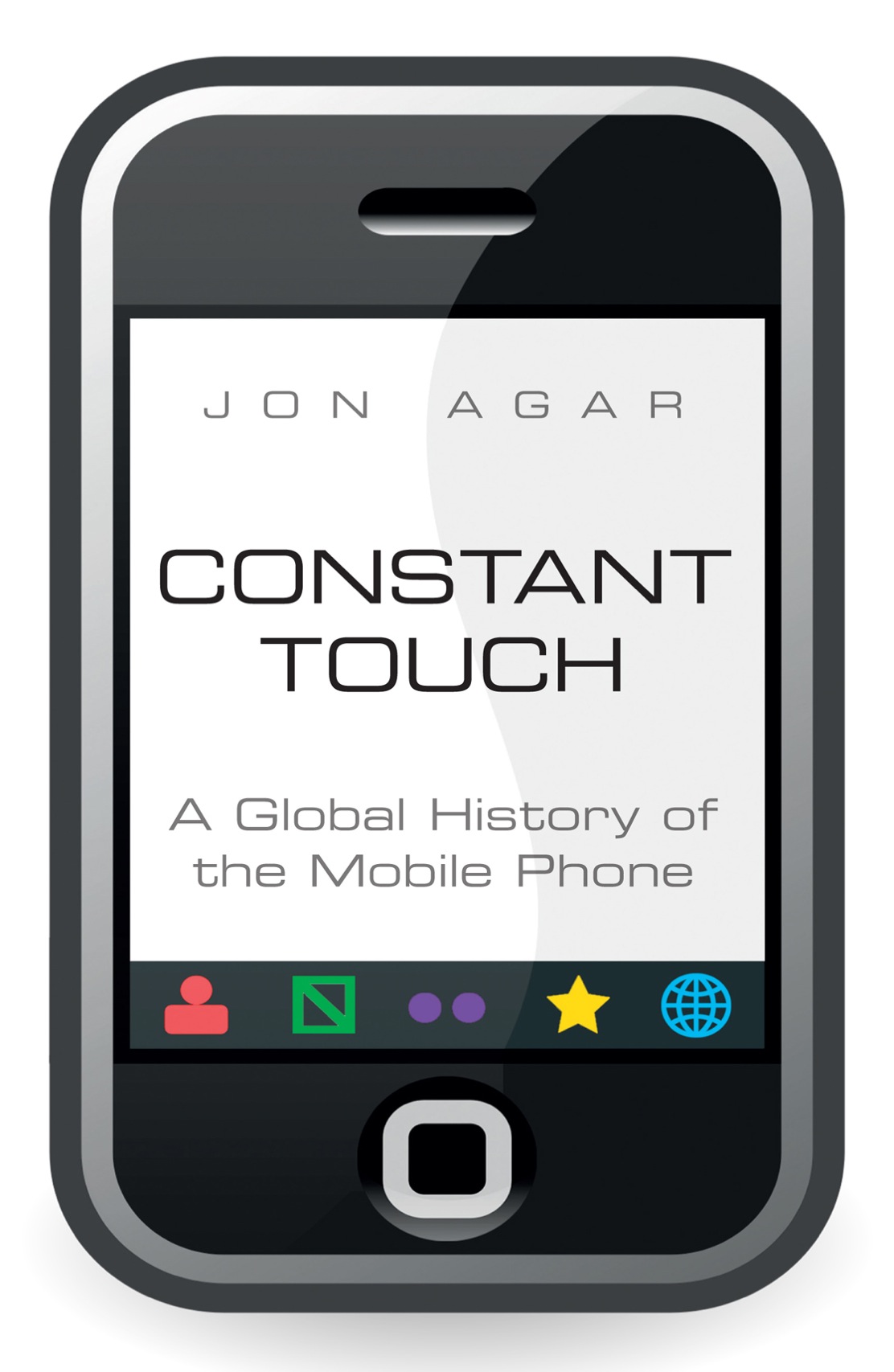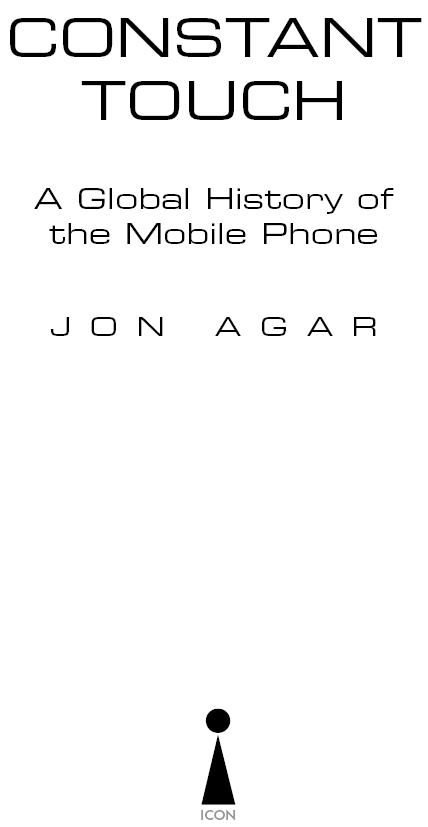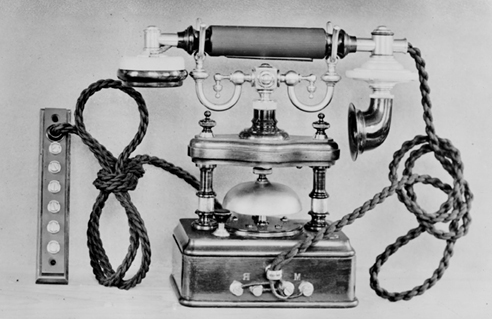Constant Touch
Authors: Jon Agar
Tags: #science, #engineering and technology, #telecommunications, #electronics and communications, #telephone and wireless technology, #internet, #mobile telephones



Printed edition (revised and updated edition) published in the UK in 2013 by
Icon Books Ltd, Omnibus Business Centre,
39â41 North Road, London N7 9DP
email:
[email protected]
Previous printed editions published in 2003 and 2004
This electronic edition published in 2013 by Icon Books Ltd
ISBN: 978-184831-526-6 (ePub format)
ISBN: 978-184831-527-3 (Adobe ebook format)
Text copyright © 2003, 2013 Jon Agar
The author has asserted his moral rights.
No part of this book may be reproduced in any form, or by any means, without prior permission in writing from the publisher.
Typeset by Marie Doherty
To Kathryn, Max and Hal (and his new Nokia 113)
Part two: Different countries, different paths to mobility
6. Europe before GSM:
La Donna è Mobile, Männer sind nicht!
9. Mob rule: competition and class in the UK
10. Decommunisation = capitalist power + cellularisation
12. For richer, for poorer: India and China
15. Two organisations in the Congo
17. The Nokia way â to the Finland base station!
18. Mobile phones as a threat to health
20. Phone hacking: a very British scandal
22. Intimately personal computers
23. 3G: a cellular world made by standards
Jon Agar
is currently Senior Lecturer in the Department of Science and Technology Studies (STS) at University College, London. He has taught history of science and technology at the universities of Manchester, Cambridge and Harvard.
For the first edition of this book, many thanks to: Cath Skinner, Jon Turney and Simon Flynn for their comments on an early draft of
Constant Touch
; the staff at the British Library and the City Business Library for their help in locating documents; Mark Tindley for some excellent impromptu research on health matters (and to the rest of the Thursday night football crowd for their âencouragement' to finish); and Brian Balmer for a good anecdote.
In preparation of this edition, my thanks to Simon Rockman (for corrections in Amazon review), to Imogen Clarke, Leucha Veneer, Jakob Whitfield and Charlotte Connelly (for kindly responding to my @jon_agar twitter plea for new movies featuring mobiles) and to Duncan Heath and Robert Sharman at Icon.
Some
books start with a small observation that lodges in the memory and niggles away until the author feels compelled to stop what they are doing and devote time and thought to understanding what they have seen.
Constant Touch
is a case in point. In the 1990s my friends started carrying around mobile phones. I was a late adopter. By the time I got my first phone, its purchase was not so much a fashion statement or the result of any love of shiny new technology as it was a necessity: if I wanted a social life then I had better get my hands on one. My friends had long dispensed with the traditional method of arranging nights out well in advance, establishing firm details such as where and precisely when we would meet. Instead, a vague indication of plans would be finalised at the last minute, coordinated in real time through texts and quick calls. I got a phone because I did not want to be left out.
I had no idea then that this mundane tool would form the subject of a book. Instead, the observation that started me down that path was made on a visit to the United States. I'm a historian of science and technology, and one of the enjoyable perks of academic life is the conference season: we meet up, we argue about interpreting the past, and swap gossip. Usually, American stories are particularly prominent in the history of
modern technology. From the second half of the 19th century through the 20th century, we are used to seeing the major innovations, as well as the defining patterns of production and consumption, emerge in the United States. Think of the works of Thomas Edison, Henry Ford and Alexander Graham Bell, or even NASA or the companies of Silicon Valley. I was going to a conference in Baltimore, where I was going to talk about a minor, if fraught, episode in the Cold War when it became an urgent project to use the moon as a relay of radio signals. In my mind I was rehearsing my case study, reflecting too on how the Cold War had pushed forward certain technologies, not least in the United States. Then I noticed something unexpected. I had come from a city, London, where cellphones were everywhere â in hands, on café tables, or close by in coat pockets. Certainly it was a novel enough development that people still complained about having to overhear personal conversations in places where usually polite etiquette ruled. But even the complaints were fading. Whinging was drowned out by ring tones. But in Baltimore the sights and sounds were different. Hardly any cellphones could be seen. When they did appear the conversations â if they even merited the term â were in contrast too: shorter, less chatty. How odd, I thought.
This small observation led me to ponder two questions. The first was why the manner of mobile phone use seemed to vary from place to place. I soon found out
that the âstyle', to use technology historian Thomas P. Hughes's terminology, of mobile phone networks as technological systems was indeed different in different countries. Furthermore, there were variations in mobile phone âculture', or the meanings and expectations we find in patterns of use, that were rich and curious. The second question concerned the United States: it was strange to find a new technology in which other parts of the world seemed to be taking the lead. Was this true? And if so, why?
The first edition of
Constant Touch
, published in 2003, explored and offered answers to these questions. It may have started with an observation about the here and now, but I believe that the patterns of contemporary life can only be understood in historical perspectives. Some of the variations in mobile phone culture across the world are therefore best analysed as the outcome of changes over time, changes in which the social, cultural, political and technological are all intimately entwined. Even by 2003 the global number of cellphone subscribers was passing a billion. This was also part of the appeal: here was a technology that was available to many, and was sometimes marketed by multinational corporations as universal, yet was being taken up in diverse and even divergent ways. The global popularity of the mobile phone was an opportunity for studying how technologies are made sense of in the world's societies and cultures.
I
was pleased with the reception accorded to the first edition of
Constant Touch
. My academic peers seemed to like it. Its âacute analysis and engaging prose' was picked out by either the
Times Literary Supplement
or the
London Review of Books
(I forget which).
Vogue
called it the âdefinitive book on the subject' â a stamp of approval that will shock and dismay anyone who has seen the way I dress. And the
Newbury Weekly News
provided a headline, âDry History Made Palatable by Entertaining Style', that still makes me smile and wish I carried business cards.
But cellphones are a fast-moving technology and by 2012 I knew, and my publishers agreed, that a new edition was needed. So much had happened, not least the transformation of the mobile phone from being primarily a tool for the communication of speech to becoming, with the smartphone especially, a richly visual, truly personal computer. However, yet again, the seed of the new book started with a commonplace observation. While the title âConstant Touch' had seemed apt because it caught the culture of informal and continuous contact found in cities such as Manila or London (if not yet Baltimore), now the words seemed applicable and important in a new way. I was travelling from home to work. I live in Dalston in the east of the capital and work at University College London. Catching the train at Dalston Kingsland, I realised, with a jolt, that every single fellow commuter was thumbing a
smartphone. Each was fully absorbed. There was no rustling of newspapers or buzz of conversation â not even the one-sided conversations of the old cellphone days that invited you, as an unwilling eavesdropper, to fill in the blanks. Here was âconstant touch' all right, but of a different kind. And I recognised it in myself.
This new, expanded edition of
Constant Touch
brings the story up to date, and in particular tries to make sense of this second observation. The mobile phone was always an intimate technology, but why did the smartphone become more intimate still? What has driven the design and the desire that are its hallmarks? One of the ways of answering this question, of course, is to pay attention to Apple, a company that was entirely absent from the first edition. The extraordinary and defining intervention by Steve Jobs' company is a compelling reminder that American innovation (albeit with Chinese production) can still spring surprises.
The book has four parts. First, I guide the reader through how a âcell' phone works, what makes it different from older, landline telephones, and where the idea came from. It is a delicious coincidence that the report proposing the cellular idea carried the name âD.H. Ring'. From Bell's telephone to Ring's cellphone? In Part two, I trace how the idea of the cellular phone was, after many years languishing, realised in the first (analogue) and second (digital) generations of mobile phones. The story, crucially, is different in different regions.
Also striking is how the mobile phone developed in close connection to other technologies of mobility, especially the automobile. Part three explores mobile cultures, as well as many other dimensions. Finally, Part four examines the mutation of this technology and culture as it became the âsmartphone'.
World in bits
What's in a phone?
You
can tell what a culture values by what it has in its bags and pockets. Keys, combs and money tell us that property, personal appearance or trade matter. But when the object is expensive, a more significant investment has been made. In our day the mobile or cellphone is just such an object. But what of the past? In the 17th century, the pocket watch was a rarity, so much so that only the best horological collections of today can boast an example from that time. But if in the following century you had entered a bustling London coffee shop or Parisian salon, then you might well have spied a pocket watch amongst the breeches and frock-coats. The personal watch was baroque high technology, a compact, complex device that only the most skilful artisans could design and build. Their proud owners did not merely buy the ability to tell the time, but also bought into particular values: telling the time mattered to the entrepreneurs and factory owners who were busy. As commercial and industrial economies began to roar, busy-ness conveyed business â and its symbol was the pocket watch.
At first sight it might seem as if owning a pocket watch brought freedom from the town clock and the church bell, making the individual independent of political
and religious authorities. Certainly, possession granted the owner powers over the watchless: power to say when the working day might begin and finish, for example. However, despite the fact that the pocket watch gave the owner personal access to the exact time, this very accuracy depended on being part of a
system
. If he was unwilling personally to make regular astronomical observations, his pocket watch would still have to be reset every now and then from the town clock. With the establishment of time zones, the system within which a pocket watch displayed the âright' time spread over the entire globe. 7.00am in New York was
exactly
12.00pm in London, which was
exactly
8.00pm in Shanghai. What is more, the owner of a pocket watch could travel all day â could be mobile â and still always know what time it was. Such certainty was only possible because an immense amount of effort had put an infrastructure in place, and agreements had been hammered out about how the system should work. Only in societies where time meant money would this effort have been worth it.
Pocket watches provide the closest historical parallel to the remarkable rise of the mobile cellular phone in our own times. Pocket watches, for example, started as expensive status symbols, but by the 20th century most people in the West possessed one. When cellular phones were first marketed they cost the equivalent of a small car â and you needed the car to transport them, since
they were so bulky. But in 2002, global subscriptions to cellular phone services passed 1 billion. By 2010 the number was 5 billion, and in 2012 it was predicted that mobile devices of all kinds would soon outnumber human beings. In many countries most people have a mobile phone. Like the pocket watch, the phone had made the leap from being a technology of the home or street to being a much rarer creature indeed: something carried everywhere, on the person, by anybody. So, if pocket watches resonated to the rhythm of industrial capitalism, what values do the ringtones of the mobile phone signify? What is it about humanity in the 21st-century world that has created a desire to be in constant touch? To answer this question, I began with a rather drastic step.
In this world of weightless information, there is nothing quite so satisfying as taking a hammer to a piece of technology. My old mobile phone, a Siemens S8, was a solid enough device, and it took some effort to take it apart. But in the interests of research I wanted to know what was inside. Now the various parts lie in front of me.
The battery came away first. It is about the size of a large postage stamp, and as heavy as a paperback book. But I can at least lift it, and this would not have been true of the early years. Let's take an example of mobile radio communication from far back. The entrepreneurial expat Italian inventor Guglielmo Marconi had
hawked his new technology of wireless telegraphy â radio communication by Morse code â around London in 1900, but he focused his efforts on one main customer: the mighty Royal Navy. His pitch was simple. The Admiralty had invested many thousands of pounds in battleships which became incommunicative and blind as soon as fog descended. Wireless telegraphy provided new mechanical senses: to warn of maritime dangers and to organise the fleet. The Sea Lords were convinced and Marconi sealed the deal. The Navy installed 32 wireless sets aboard ships. Sixteen years later, during the Battle of Jutland, the purchase would
prove a wise one: listening stations detected the German fleet by picking up unusually heavy radio traffic, and the same radio technology enabled the British Grand Fleet to steam across the foggy North Sea to the Danish coast to engage its enemy in the Skagerrak.

Guglielmo Marconi.
Marconi wanted to sell wireless to the Admiralty because it took a vehicle the size and power of a battleship to carry it. Radio transmission in the 1900s had been achieved by creating bursts of sparks generated by immense electrical voltages. (The same principle is behind the crackling interference caused by lightning.) Giant voltages meant heavy batteries. The first mobile radio was restricted to behemoths. But a feature of the history of electrical technology has been continuous miniaturisation of components. Even before the First World War, the Swedish electrical engineer Lars Magnus Ericsson had demonstrated new possibilities for mobile communication.
The young Ericsson had trained as a smith and as a mining and railway engineer before becoming an apprentice under the telegraph-maker A.H. Ãller in the early 1870s. He then studied abroad in Switzerland and Germany before setting up his own company in Stockholm in 1876, first to manufacture and repair telegraph apparatus, and later, following Alexander Graham Bell's invention, telephones. Ericsson's business boomed. However, he seems to have wearied of the commercial life early in the new century, and retired,
backed by a healthy bank balance, to a comfortable life as a farmer. But in 1910 Ericsson, in the spirit of tinkering, built a telephone into his wife Hilda's car: the vehicle connected by wires and poles to the overhead telephone lines that had sprung up even in rural Sweden. Enough power for a telephone could be generated by cranking a handle, and, while Ericsson's mobile telephone was in a sense a mere toy, it did work.

An Ericsson table telephone, c. 1900. (BT Archives)
At one level the story of the retired Swedish engineer-turned-farmer is trivial: no great industry of car-carried mobile telephones was founded on the experiment. But in many other ways it was significant. Ericsson's company, after many twists and turns, would supply much of the infrastructure for the cellular phone systems built in the late 20th century. More of that later. Secondly, the experiment happened in Sweden, and the Nordic
countries have a remarkable prominence in the history of the mobile phone. Finally, Ericsson's vehicle showed that the technologies of communication could be fitted in an automobile, the first instance in a long and profound association between two technologies of mobility that have shaped our modern world.
Marconi's weighty wireless had to be carried by battleship. Early practical mobile phones were carried by cars, since there was room in the boot for the bulky equipment, as well as a car battery to power them. One of the most important factors permitting phones that can be carried in pockets and bags has been a series of remarkable advances in battery technology. As batteries have become more powerful, so they have provided more energy. Partly because improvements in battery design have been incremental, their role in technological change is often underestimated. The great Prussian physicist Walther Hermann Nernst, who later articulated the Third Law of Thermodynamics, had experimented in Göttingen in 1899 with nickel as a means of converting chemical energy into electrical energy. Built a century later, my disintegrated phone has a Ni-MH â Nickel Metal Hydride â battery; it is in one sense recognisably similar to Nernst's, but in another it is transformed: it is many, many times lighter and more efficient. Step-by-step, nickel batteries have got better. Continuous experimentation with other metals has revealed slight but significant improvements, so
that, for example, the early-21st-century choice for mass-produced energy packs is between nickel- and lithium-based techniques. Gradual change can eventually trigger a profound revolution. Once batteries became powerful
and
portable, a Rubicon was crossed. Uncelebrated improvements in batteries, put into laptops, camcorders and cellphones, triggered our mobile world.
A similar story can be told of the other bits and pieces in front of me. The LCD or liquid crystal display, the grey panel on which I read my incoming call numbers or SMS messages on my old phone, is now commonplace in consumer electronics. The contradictory properties of liquid crystals â fluids that can paradoxically retain structure â had been noted in the 19th century by the Austrian botanist Friedrich Reinitzer. He had noticed that the organic solid cholesteryl benzoate seemed to have two melting points, and that between the lower and higher temperatures the liquid compound behaved oddly. But it was not until the 1960s that industrial laboratories, such as RCA's in America, began to find applications exploiting this behaviour. Again, incremental development followed. Liquid crystal displays don't produce light, they reflect light, which potentially saves energy, so changes in one component (displays) interacted with another (batteries). Much effort was needed to turn this advantage into a practical one. However, by the 1970s LCDs appeared in
calculators and digital watches, replacing the red glow of light-emitting diodes.
LCDs were not essential ingredients of a cellphone (indeed my new smartphone has ditched this old display technology). We could keep in constant touch with a simple assemblage of the other bits and pieces found in the wreckage of my phone: aerials, microphones, loudspeakers and electronic circuitry. But improved screens are part of what makes a mobile phone more than a mere instrument of communication. We don't just talk. Without the screen, the extra aspects of the mobile phone â the games, YouTube, the address books, the text messaging â all the features which contribute to a rich mobile culture, involving manipulation of data as well as transmission of the voice, would not be possible.
If I had superhuman strength I could hammer my phone into constituent atoms. A new global politics can be found among the dust. Mobile phones depend on quite rare materials: for example, within every phone there are ten to twenty components called capacitors, which store electrical charges, and since the Second World War the best capacitors have been made using thin films of a metal called tantalum. On the commodities market in the early 1990s, capacitor-grade tantalum could usually be bought for $30 a pound, sourced from locations such as the Sons of Gwalia mines at Greenbushes and Wodgina in Western Australia, the world's best source of the element. But in the last years of
the 20th century, as more and more people bought mobile phones, the demand for tantalum shot up. The price per pound rose to nearly $300 in 2000.
Tantalum, in the form of columbite-tantalite (âcoltan' for short), can also be found in the anarchic north-east regions of the Democratic Republic of Congo, where over 10,000 civilians have died and 200,000 have been displaced since June 1999 in a civil war, fought partly over strategic mineral rights, between supporters of the deceased despot Laurent Kabila and Ugandan and Rwandan rebels. As the price of tantalum increased, the civil war intensified, funded by the profits of coltan export. The mobile phone manufacturers are distanced, however, from the conflict. Firms such as Nokia, Ericsson, Samsung and Motorola buy capacitors from separate manufacturers, who in turn buy raw material from intermediaries. On each exchange, the source of tantalum becomes more deniable. âAll you can do is ask, and if they say no, we believe it,' Outi Mikkonen, communications manager for environmental affairs at Nokia, recently said of her firm's suppliers. On the other hand, export of tantalum from Uganda and Rwanda has multiplied twentyfold in the period of civil war, and the element is going somewhere.
